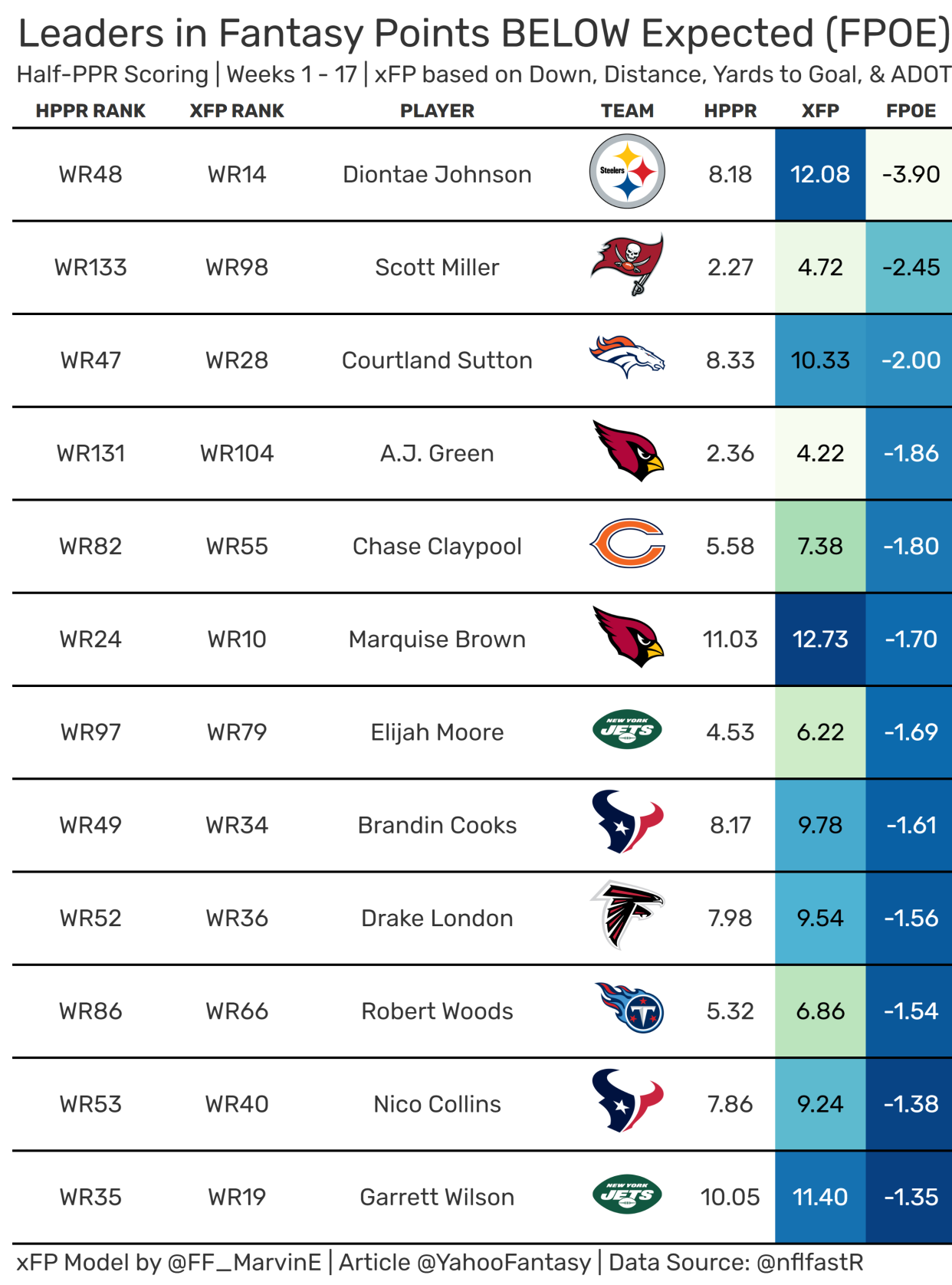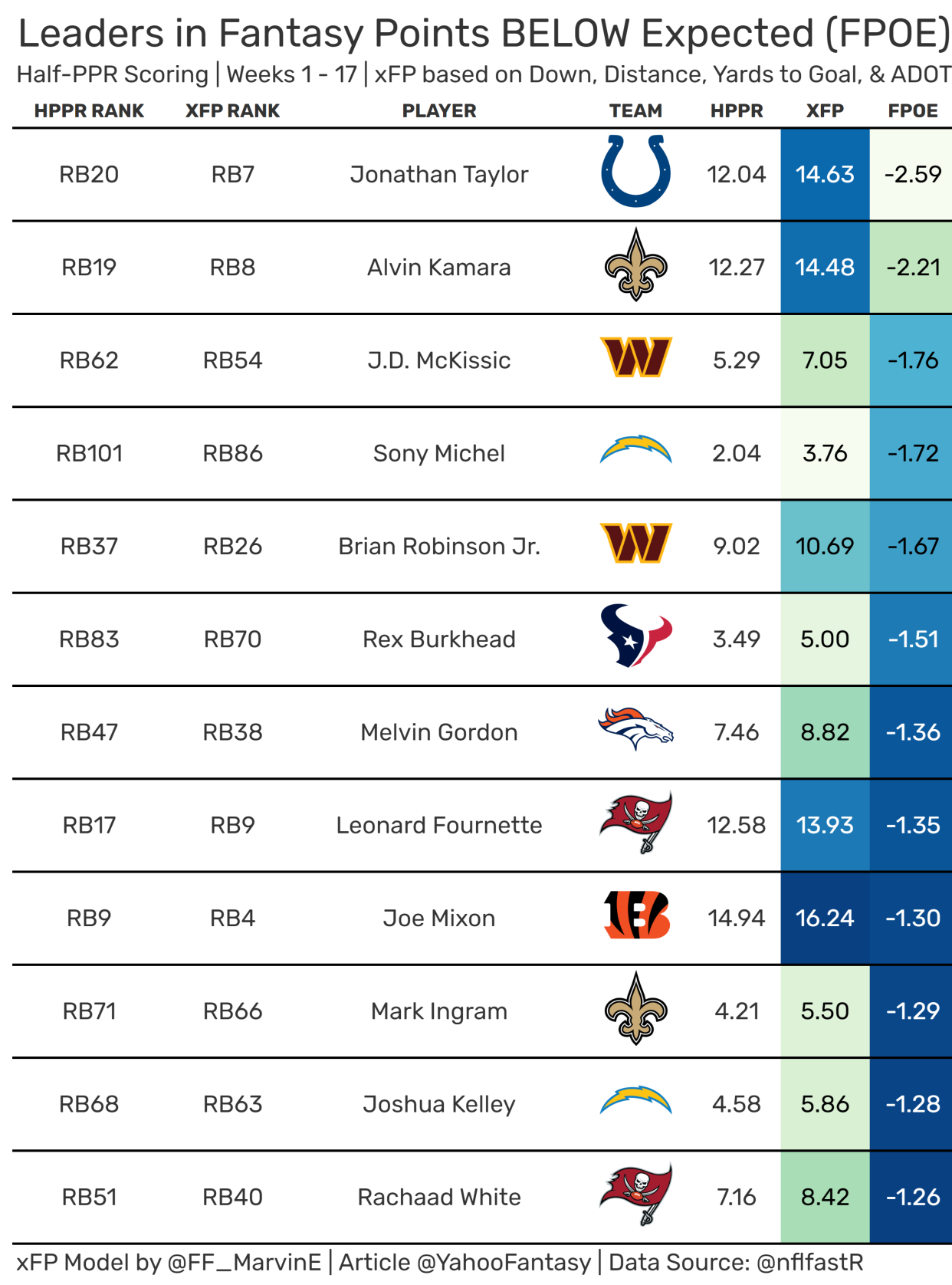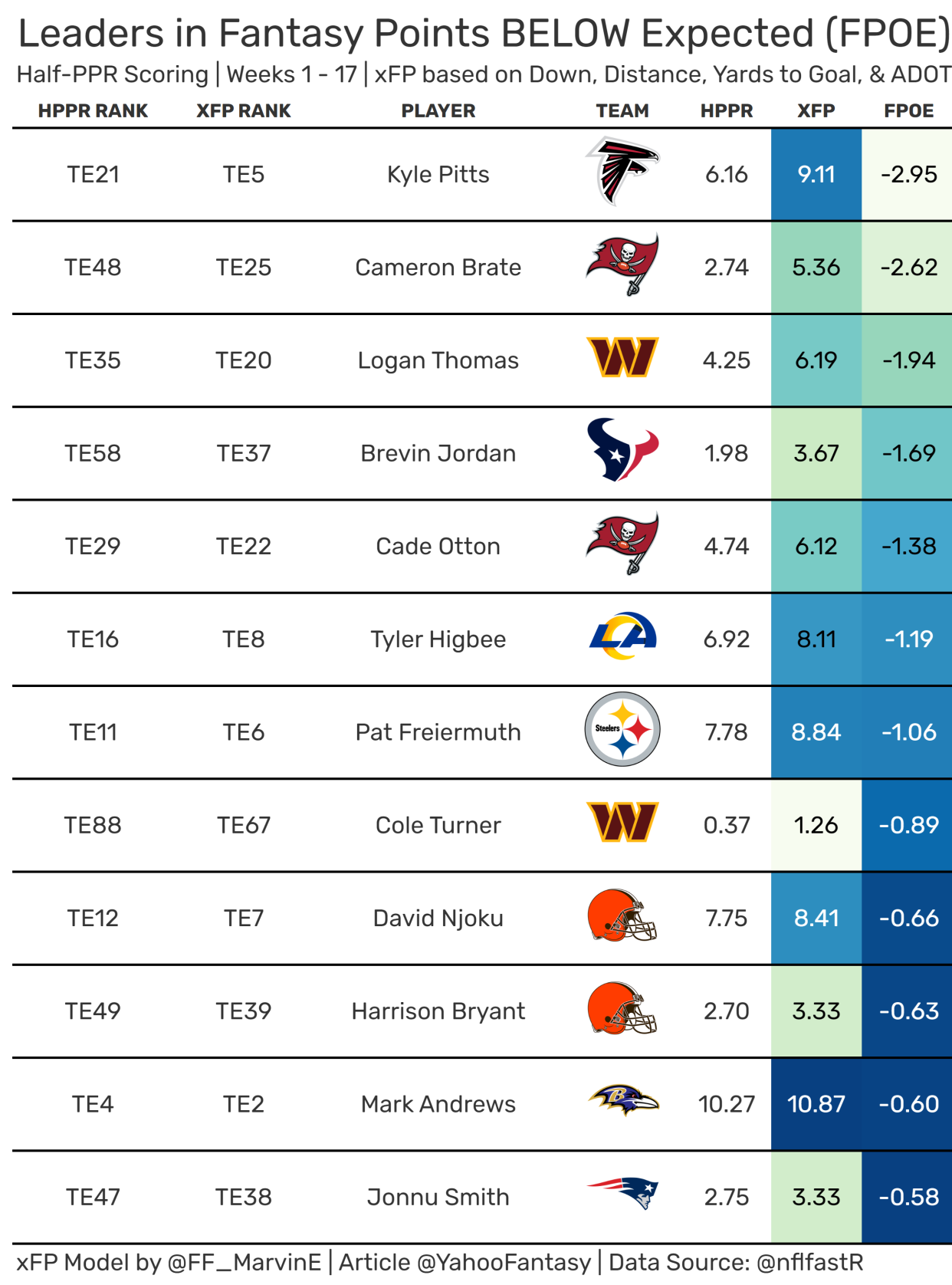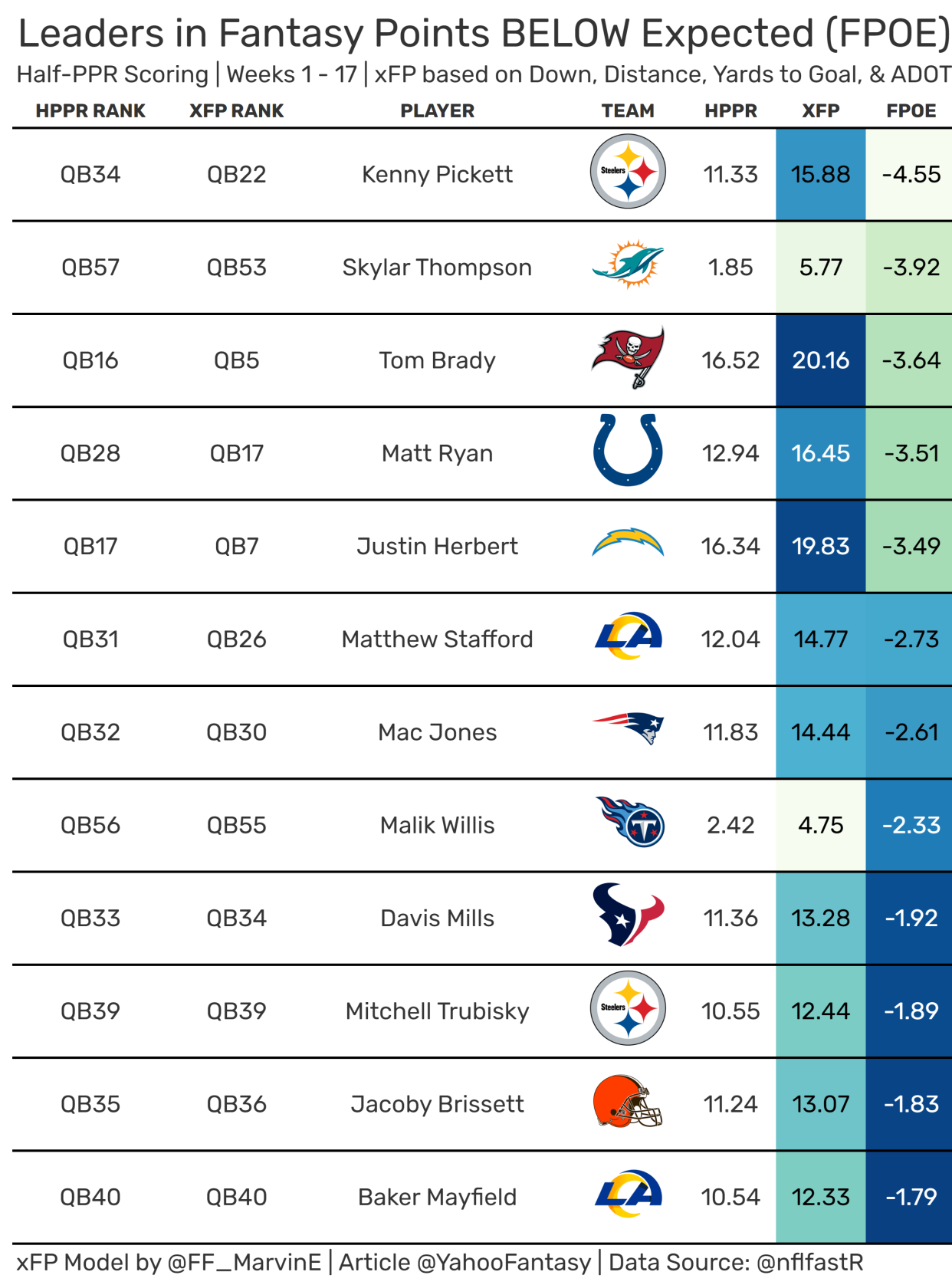Fantasy Football: Which of 2022's most underperforming players will turn it around in 2023?
Welcome back, fantasy managers. In this piece, we will be focusing on the most inefficient players this season. In other words, these players totaled the most Fantasy Points below their Expected Fantasy Value.
If you are new to this series, you might be wondering what those metrics mean.
Expected Fantasy Points (xFP): A usage metric that calculates the average fantasy value of a player’s total opportunities based on historical play-by-play data.
Fantasy Points Over (or Below) Expected (FPOE = Actual Points - Expected Points): An efficiency metric that is often subject to regression year over year. Players who rely on FPOE to produce are much more volatile on a weekly basis.
Keep in mind, efficiency does not always correlate to fantasy production, which is why we need to incorporate usage (or xFP) into the evaluation. In other words, with enough volume, players can still be productive for fantasy, despite being slightly inefficient. Lastly, all stats outlined below are “per game” unless stated otherwise.
For a more detailed breakdown of these metrics, check out my series primer from Week 1! And check out Part 1 of this series examining the players who overperformed their Expected Fantasy Value!
Let’s dive in!

Diontae Johnson, Pittsburgh Steelers
After two straight seasons finishing as a top-24 wide receiver in half-PPR leagues, Johnson had the most inefficient campaign of his career. As you can see in the chart above, he severely underperformed, as he scored 3.9 fantasy points below expected per game.
A significant reason for his inefficient fantasy season was his lack of end-zone production. Playing alongside a rookie quarterback was clearly part of the problem, as Kenny Pickett was last in the league in touchdown percentage at 1.8%. As a result, Johnson became the only wide receiver since 1992 to receive more than 140 targets without scoring a receiving touchdown in a season.
On a positive note, Johnson was still the WR14 in usage, with 12.1 xFP and an elite 26.4% target share. In other words, from a volume standpoint, he was the WR1 for Pittsburgh. Assuming Pickett progresses this offseason, I would expect a much more efficient year for the entire offense next season, potentially vaulting Johnson back into WR2 territory.
Marquise Brown, Arizona Cardinals
Brown’s first campaign with the Cardinals started on a high note, as he was one of the most productive wide receivers in the league in his first six games. From Weeks 1 to 6, Brown averaged an impressive:
26.3% Target Share
40.5% Air Yards Share
14.4 Expected Fantasy Points
+0.3 Fantasy Points Over Expected
The only wide receivers to average a higher expected fantasy value than Brown were Davante Adams, Cooper Kupp, Justin Jefferson, Ja’Marr Chase and Stefon Diggs.
Unfortunately, a foot fracture halted Brown's impressive season, forcing him to miss five games. And shortly after he returned, Kyler Murray suffered a torn ACL, essentially ending the Cardinals’ season. As a result, Brown averaged 4.10 points below expected in his final five games, receiving passes from David Blough, Colt McCoy and Trace McSorley.
While his full-year stats are not as impressive, Brown’s first six games provide a much better indicator of what we can expect from him in 2023.

Jonathan Taylor, Indianapolis Colts
After spoiling fantasy managers with a historic season in 2021, Taylor was much less efficient this year.
First of all, he set single-season career lows in a variety of metrics in 2022, including yards per touch (4.6), Rushing Yards Over Expected per carry (0.56) and touchdown rate (1.7%). In simpler terms, he averaged fewer yards and touchdowns per opportunity, which is why his season felt like a massive disappointment after fantasy managers selected him with their first overall pick. As a result, it should not be a shock that he ranked last in my usage model in Fantasy Points Over Expected per game.
With these numbers in mind, should you select Taylor with a top-three pick next season? Absolutely.
As I mentioned in the intro, efficiency is subject to regression and can swing in the other direction from season to season. Instead of focusing on his inefficiency, we need to remember that Taylor was the RB7 in usage (Expected Fantasy Points) despite an injury-riddled campaign.
As long as he remains the focal point of the Colts' offense, I fully expect another RB1 season from Taylor in 2023.
Brian Robinson Jr., Washington Commanders
It was a disappointing year for the Commanders, as they struggled to find any consistency on offense, relying on multiple quarterbacks throughout the season. However, one of the more consistent players on their team was Robinson, who assumed the lead running back role midway through the year. Once he was named the starter in Week 6, he was the RB22 in Expected Fantasy Points (11.2) and the RB17 in Opportunity Share (30.1%) in his final 11 games.
While his usage numbers indicate that he should have been an RB2, he averaged 1.67 fantasy points below expected, bringing his production down to FLEX value. This was partially due to the inefficiencies of the Commanders' offense, ranking in the bottom 10 in red-zone plays and red-zone conversion rate this season. As a result, despite his tremendous volume, Robinson scored only three times this season. In addition, he was barely utilized in the passing game (3.8% Target Share), further limiting his upside in PPR formats.
In short, it was encouraging to see Robinson assume such a heavy workload for Washington. Assuming that continues, he should be an RB3 at the very least next season. However, until the team finds a quarterback who can consistently move the offense, his upside will remain limited in 2023.

Kyle Pitts, Atlanta Falcons
Remember when Pitts was supposed to be a top-tier option at the tight end position?
While he finished the season with the lowest Fantasy Points Over Expected (-2.95), there are multiple reasons to be encouraged heading into 2023. First of all, he was the TE5 in Fantasy Usage with a 9.1 Expected Fantasy Value. To provide some context on his impressive usage, Pitts and Mark Andrews were the only tight ends to average more than a 25% target share and 30% air yards share this year.
Secondly, despite being targeted heavily downfield, Pitts led all tight ends in unrealized air yards (541) and was only the TE37 in Catchable Target Rate. In other words, Marcus Mariota was not the most accurate passer this season, severely limiting Pitts’ weekly upside.
The good news, however, is the Falcons will have a new starting quarterback in 2023, which should lead to a more efficient and productive year for Pitts.

Justin Herbert, Los Angeles Chargers
After he finished last season as the QB3 in points per game, the expectations for Herbert this season were very high. However, his production took a slight step back, as he was only the QB17 in points per game through Week 17, scoring 3.5 fantasy points below his expected value (19.8). In fact, Herbert averaged the lowest yards per attempt (6.8) and touchdown rate (3.6%) of his career, likely driven by the plethora of injuries to his offensive line and wide receivers.
What does this mean for Herbert’s 2023 outlook? Assuming the Chargers continue to add talent to this offense, and both Keenan Allen and Mike Williams remain healthy through the offseason, I expect Herbert’s efficiency to regress positively to the mean. Therefore, in one of the most pass-heavy offenses in the league (QB7 in Expected Fantasy Points), he should continue to hold top-tier QB1 upside for fantasy managers in 2023.
